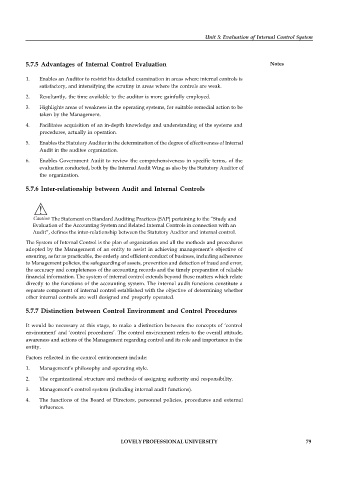Page 84 - DCOM509_ADVANCED_AUDITING
P. 84
Unit 5: Evaluation of Internal Control System
5.7.5 Advantages of Internal Control Evaluation Notes
1. Enables an Auditor to restrict his detailed examination in areas where internal controls is
satisfactory, and intensifying the scrutiny in areas where the controls are weak.
2. Resultantly, the time available to the auditor is more gainfully employed.
3. Highlights areas of weakness in the operating systems, for suitable remedial action to be
taken by the Management.
4. Facilitates acquisition of an in-depth knowledge and understanding of the systems and
procedures, actually in operation.
5. Enables the Statutory Auditor in the determination of the degree of effectiveness of Internal
Audit in the auditee organization.
6. Enables Government Audit to review the comprehensiveness in specific terms, of the
evaluation conducted, both by the Internal Audit Wing as also by the Statutory Auditor of
the organization.
5.7.6 Inter-relationship between Audit and Internal Controls
!
Caution The Statement on Standard Auditing Practices (SAP) pertaining to the “Study and
Evaluation of the Accounting System and Related Internal Controls in connection with an
Audit”, defines the inter-relationship between the Statutory Auditor and internal control.
The System of Internal Control is the plan of organization and all the methods and procedures
adopted by the Management of an entity to assist in achieving management’s objective of
ensuring, as far as practicable, the orderly and efficient conduct of business, including adherence
to Management policies, the safeguarding of assets, prevention and detection of fraud and error,
the accuracy and completeness of the accounting records and the timely preparation of reliable
financial information. The system of internal control extends beyond those matters which relate
directly to the functions of the accounting system. The internal audit functions constitute a
separate component of internal control established with the objective of determining whether
other internal controls are well designed and properly operated.
5.7.7 Distinction between Control Environment and Control Procedures
It would be necessary at this stage, to make a distinction between the concepts of ‘control
environment’ and ‘control procedures’. The control environment refers to the overall attitude,
awareness and actions of the Management regarding control and its role and importance in the
entity.
Factors reflected in the control environment include:
1. Management’s philosophy and operating style.
2. The organizational structure and methods of assigning authority and responsibility.
3. Management’s control system (including internal audit functions).
4. The functions of the Board of Directors, personnel policies, procedures and external
influences.
LOVELY PROFESSIONAL UNIVERSITY 79

